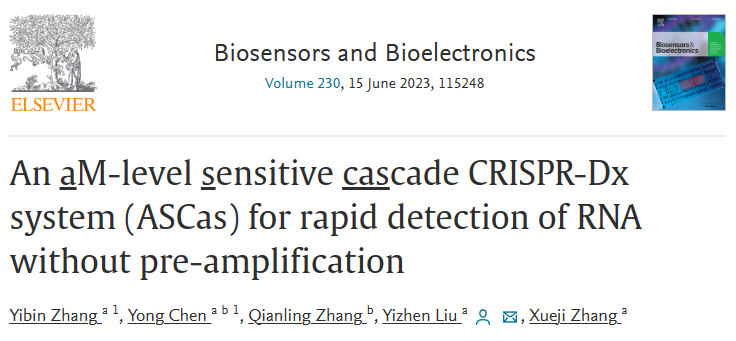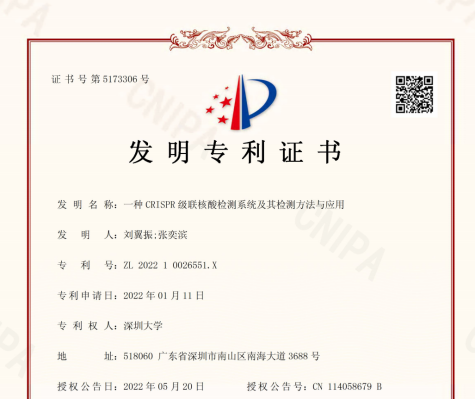The CRISPR/Cas system is considered one of the next-generation mainstream molecular diagnostic technologies. However, due to the limited sensitivity of the CRISPR/Cas system, most existing CRISPR molecular diagnostics (CRISPR-Dx) still rely on pre-amplification of nucleic acids, and non-amplified CRISPR-Dx still face challenges, making it difficult to meet the needs of POCT clinical testing.
To address these issues, Liu Yizhen's molecular diagnostic technology research group at Shenzhen University has made important progress in the direction of CRISPR/Cas molecular diagnostics, proposing an aM-level sensitive cascade CRISPR-Dx system (ASCas). This system is a non-amplified, highly sensitive (1 aM), and rapid (20 minutes) RNA detection system for SARS-CoV-2 virus. In the ASCas system, the highly sensitive and highly cleavage-efficient Cas13a nucleic acid enzyme can rapidly cleave the RNA bubbles on the cascade probes in low-concentration targeted RNA detection, thus destroying the cascade probes and releasing a large amount of trigger DNA for further secondary Cas12a reaction signal amplification. The ASCas system can rapidly detect aM-level SARS-CoV-2 RNA without reverse transcription and pre-amplification. This groundbreaking non-amplified CRISPR-Dx technology eliminates the risk of aerosol contamination caused by amplification reactions and greatly reduces the environmental and personnel skill requirements of molecular diagnostics. In addition, the ASCas system replaces the complex primer and probe screening process with programmed designed Cas13a-crRNA, which can be used to construct detection systems for RNA viruses such as SARS-CoV-2 that are prone to mutation more quickly and intuitively.

The research paper, titled "An aM-level sensitive cascade CRISPR-Dx system (ASCas) for rapid detection of RNA without pre-amplification" was published in the top journal in the field of biosensors and bioanalysis, Biosensors and Bioelectronics (impact factor 12.545, Chinese Academy of Sciences Q1, TOP journal), in the form of Short Communications. Zhang Yibin, a master's student in the College of Chemistry and Environmental Engineering at Shenzhen University, and Associate Researcher Chen Yong are co-first authors, and Associate Professor Liu Yizhen is the corresponding author. Shenzhen University is the first communication unit, and the full text is available at:
https://www.sciencedirect.com/science/article/pii/S0956566323001902.
The research achievement, "A CRISPR cascade nucleic acid detection system and its detection method and application," has been granted a national invention patent, with the patent number ZL202210026551.X.


The outbreak of the novel coronavirus (SARS-CoV-2) has seriously damaged global human health and economic development. Studies have shown that timely diagnosis and isolation are the most effective methods to prevent the spread of epidemics. However, the current molecular diagnostic platform based on polymerase chain reaction (PCR) faces problems such as expensive equipment, difficult operation, and the need for stable power resources, making it difficult to promote and apply in resource-poor areas.
To solve this problem, Liu Yizhen's research group has successfully developed a portable (<300g), low-cost (<$10), and reusable molecular diagnostic device based on solar thermal conversion strategy. It introduces a sunflower-like automatic light tracking system, which improves the utilization of solar energy and makes the device suitable for high and low light environments. The experiments have shown that the device can detect SARS-CoV-2 nucleic acid samples as low as 1 aM within 30 minutes.

The breakthrough innovation of this technology lies in the use of solar thermal conversion strategy, which makes the device portable, low-cost, and reusable, greatly reducing diagnostic costs. The device can rapidly heat up and initiate constant temperature amplification reactions under different lighting conditions. It has high detection sensitivity and can quickly detect the SARS-CoV-2 virus in low-concentration nucleic acid samples, which is of great significance for the development of on-site real-time molecular diagnostic technology.

This research result was published in the form of a Short Communication in the renowned analytical chemistry journal Talanta (impact factor 6.556, Chinese Academy of Sciences Q1, TOP journal). The title of the paper is "A Portable Thermostatic Molecular Diagnosis Device based on High-efficiency Photothermal Conversion Material for Rapid Field Detection of SARS-CoV-2". Yang Xinyao, an undergraduate student of the Chemistry Innovation Class of Shenzhen University in 2021, is the first author of the paper, and Associate Researcher Chen Yong and Associate Professor Liu Yizhen are the co-corresponding authors of the paper. Shenzhen University is the first completion unit, and the full article is available at:
https://www.sciencedirect.com/science/article/pii/S003991402300173X
This research received strong support from the National Natural Science Foundation, the Guangdong Provincial Natural Science Foundation, and the Shenzhen Municipal Natural Science Foundation.
